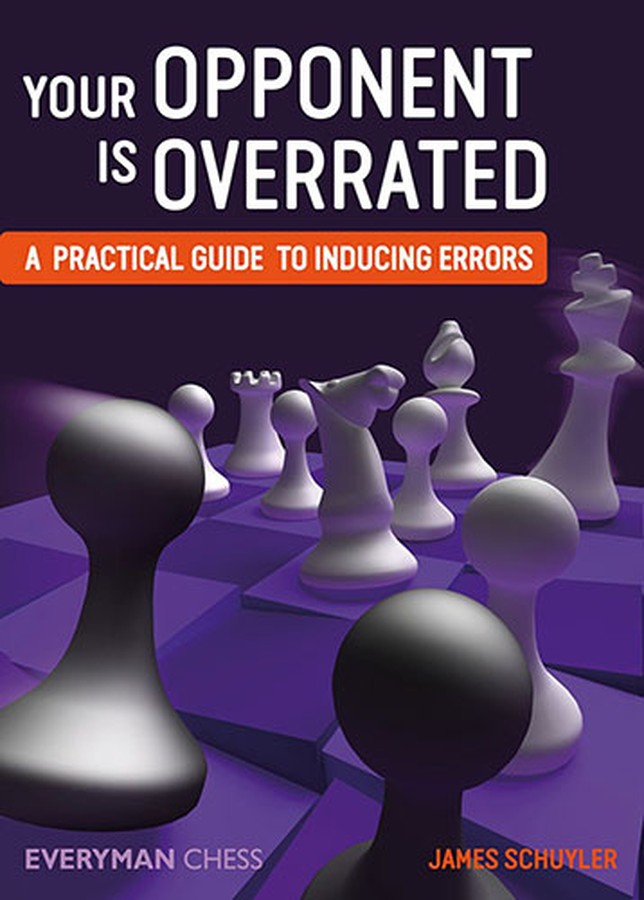| Nivå | B-D |
| Utgivelsesdato | Oktober 2016 |
| Forfatter | |
| Pris | 265 NOK |
Your Opponent is Overrated
A practical guide to inducing errorsBoka har fått en "salgbar" tittel om rating. Forfatteren forteller at den egentlig skulle hete "No draw!", som passer godt på innholdet at bedre resultater ikke kommer av å spille litt mer perfekt, men å hjelpe motspillerne til å gjøre feil.
Forlagets egen omtale:
Which opening does better in practice: the wild, “unsound” and “refuted” Latvian Gambit (1 e4 e5 2 Nf3 f5) or the solid Philidor Defence (1 e4 e5 2 Nf3 d6)? As James Schuyler points out, referring to the definitive Megabase, the Latvian Gambit scores higher.
How can such a discredited opening (and the same story is repeated with other “unsound” openings) do so well? The point is that playing like this throws the opponent off balance, makes them anxious and induces mistakes.
Even the very best players recognise the value of discomforting the opponent. Historically, Emanuel Lasker was the master of this approach and his modern day equivalent is world champion Magnus Carlsen. Carlsen frequently employs offbeat openings and his opponents invariably fail to counter them correctly.
This is the key theme of this book. Schuyler covers all phases of the game and discusses other vital subjects such as harassment, material imbalance, time management, surprise moves, unusual ideas, provocative play, manoeuvres and recovering from bad positions.
- Includes methods to improve practical play
- Develops a win-oriented attitude
- Examines ways to induce mistakes
James Schuyler is a FIDE Master. He was Nevada State Champion in 2007 and won the Virginia State Championship in both 2011 and 2012. He has been teaching chess for over 25 years.
Starten av forfatterens innledning:
The Problem
We all play about as well as we can manage, given the amount of effort we can spare for chess. We have our ratings and a certain average percentage of wins (plus draws divided by two) that we can expect depending on the level of our opposition. We read books to improve, and study openings, but after a certain point this doesn’t seem to have any impact. Perhaps this is because our study is generally based on the premise that the only road to improving our results is to improve our accuracy. Some of us may need to think about chess in a much different way.
Your Opponent
We have a fallible opponent. He’s messing up every game. Even when he stumbles upon the right moves, it’s often for the wrong reasons. I’d even go so far as to say he’s overrated. And yet if we play our “normal best” game those errors may not appear frequently, and they may not be severe. Surely there is some wa y to expose his ignorance. But he’s familiar with the common tricks and traps. We’ll need to be subtle. Cagey. Persistent. Overwhelm- ing. So we will not merely go about our business – we will at times go out of our way and actively induce errors in our opponent’s play. Right?
No Draw!
The originally intended title for this book was “No Draw!” As it turns out, avoiding draws and inducing errors generally amount to the same thing. There is no way to win otherwise drawn games without inducing errors, so it is really the same subject, and I believe I may use the phrases nearly interchangeably. The benefits of avoiding draw s are considerable, even if it does not improve a player’s results overall. It is a very common occurrence in tournaments that we need to win a particular game. Perhaps there is money on the line , or a tournament title, or a Master title that depends on temporarily achieving a certai n rating. Naturally, we want to play as well as we can, but there is an additional consid eration because a draw may be worthless, or nearly worthless. Should we play our “normal best” game, or can we do better by playing differently to avoid a draw? Obviously, it is pointless to avoid draws if all those draws turn into losses, but if some of those draws (let’s say about half) can be turned into wins, we increase our chances of achieving our goals. That is what this book is about, though as we go on, we may realize that it is about other things as well. Allow me to elaborate on this, since it helps explain why it might be so important to play fewer draws.
| Innbundet? | Nei |
| Type | Bok |
| Språk | Engelsk |
| Antall sider | 220 |

